

Poetry 180 - Home Page. Welcome to Poetry 180.
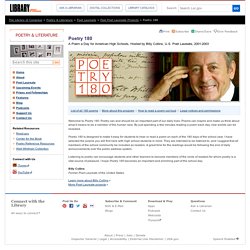
Poetry can and should be an important part of our daily lives. Poems can inspire and make us think about what it means to be a member of the human race. By just spending a few minutes reading a poem each day, new worlds can be revealed. Poetry 180 is designed to make it easy for students to hear or read a poem on each of the 180 days of the school year. I have selected the poems you will find here with high school students in mind. Listening to poetry can encourage students and other learners to become members of the circle of readers for whom poetry is a vital source of pleasure. Billy Collins Former Poet Laureate of the United States Learn more about Billy Collins More Poet Laureate projects. Time For Kids. Kids' Games, Animals, Photos, Stories, and More. Reading Brain. Websites for Kids.
Check out some of our favorite reading websites for kids that teach Letter Knowledge, Phonemic Awareness, Alphabetic Principle (Basic & Advanced Code), Fluency, Vocabulary, and Comprehension!
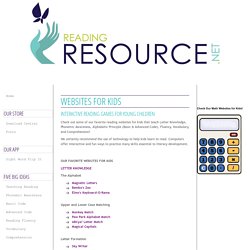
We certainly recommend the use of technology to help kids learn to read. Computers offer interactive and fun ways to practice many skills essential to literacy development. The Alphabet Upper and Lower Case Matching Letter Formation ABC Order Back to Top Beginning Sounds Ending Sounds Rhyming Blending/Segmenting Sounds Deleting Sounds Pumpkin Patch Manipulating Sounds Manipulating Sentences Lionel's Talking Gizmo Back to Top Basic Code/Nonsense Words Advanced Code Read & Listen Punctuation Sentence Construction Kung-Fu Sentences Classifying Flood! Synonyms & Antonyms Homophones Contractions Vocabulary Words Prefixes and Suffixes Nouns, Verbs, and Adjectives Comprehension Strategies In the Book. Starfall's Learn to Read with phonics.
Story Map. The Story Map interactive includes a set of graphic organizers designed to assist teachers and students in prewriting and postreading activities.
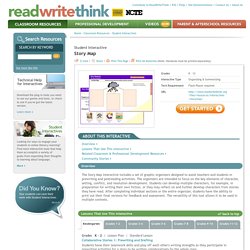
The organizers are intended to focus on the key elements of character, setting, conflict, and resolution development. Students can develop multiple characters, for example, in preparation for writing their own fiction, or they may reflect on and further develop characters from stories they have read. After completing individual sections or the entire organizer, students have the ability to print out their final versions for feedback and assessment. The versatility of this tool allows it to be used in multiple contexts. Grades K – 2 | Lesson Plan | Standard Lesson Collaborative Stories 1: Prewriting and Drafting Students hone their teamwork skills and play off each other's writing strengths as they participate in prewriting activities for a story to be written collaboratively by the whole class.
Word Family Sort. This online activity is designed for beginning and struggling readers to help them recognize word patterns and learn about onset and rime.

Students are first asked to select a vowel, and are then presented with a series of words to sort into short-vowel word families. Students can then print their completed word family chart and use it to practice reading the words fluently. This activity is modeled after the word family sort referenced in Small Group Reading Instruction: A Differentiated Teaching Model for Beginning and Struggling Readers by Beverly Tyner (International Reading Association, 2004). Grades 3 – 5 | Lesson Plan | Recurring Lesson Sort, Hunt, Write: A Weekly Spelling Program It's easy to make spelling fun.
Grades K – 2 | Student Interactive | Learning About Language. Plot Diagram. Home › Classroom Resources › Student Interactives Student Interactive The Plot Diagram is an organizational tool focusing on a pyramid or triangular shape, which is used to map the events in a story.
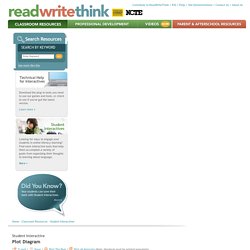
This mapping of plot structure allows readers and writers to visualize the key features of stories. The basic triangle-shaped plot structure, representing the beginning, middle, and end of a story, was described by Aristotle. Gustav Freytag modified Aristotle's system by adding a rising action and a falling action to the structure. Grades K – 2 | Lesson Plan | Standard Lesson Teaching About Story Structure Using Fairy Tales From "once upon a time" to "happily ever after," students learn to recognize story structure in fairy tales and create a logical sequence of events when writing original stories.
Related Classroom & Professional Development Resources. Compare & Contrast Map. This interactive graphic organizer helps students develop an outline for one of three types of comparison essays: whole-to-whole, similarities-to-differences, or point-to-point.
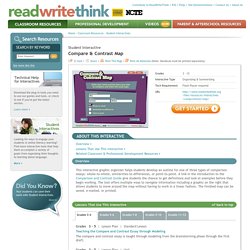
A link in the introduction to the Comparison and Contrast Guide give students the chance to get definitions and look at examples before they begin working. The tool offers multiple ways to navigate information including a graphic on the right that allows students to move around the map without having to work in a linear fashion. The finished map can be saved, e-mailed, or printed. Grades 3 – 5 | Lesson Plan | Standard Lesson Teaching the Compare and Contrast Essay through Modeling The compare and contrast essay is taught through modeling from the brainstorming phase through the first draft.
Grades 3 – 5 | Lesson Plan | Unit Examining Plot Conflict through a Comparison/Contrast Essay Students explore picture books to identify the characteristics of four types of conflict.